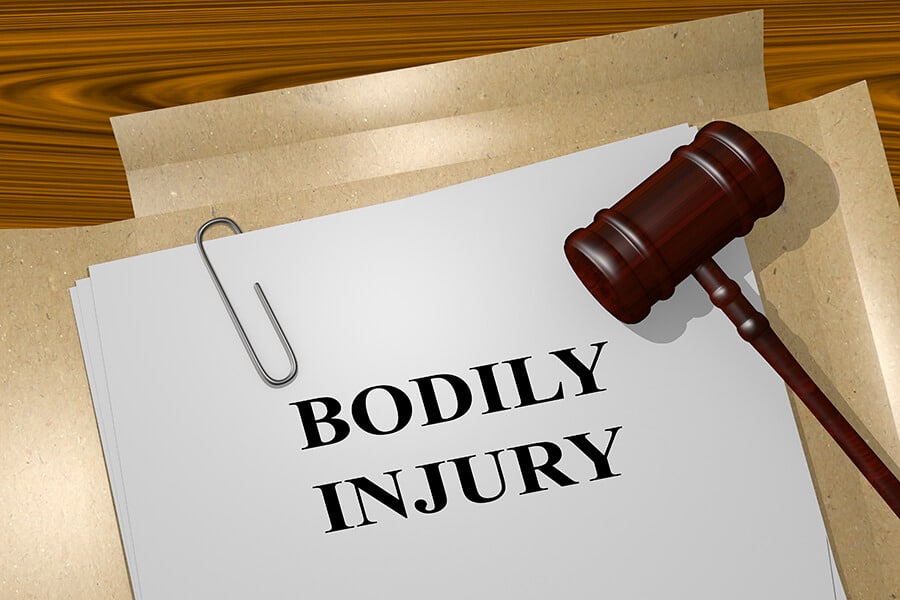
One of the most frequent questions asked by victims of car accidents is “How much are my injuries worth?”
The truth is, there’s no simple answer to this question. There are a number of factors that can impact claim settlement amounts, all the more reason why you need to have uninsured motorist bodily injury coverage.
In some states, comparative fault is used as a way to determine how much the victim receives for their medical bills. This means that depending of how much the driver who hit you is at-fault (in percentages), those percentages apply to your medical bills.
For example, let’s assume that the driver is found responsible for 80% of the bodily injury because your brakes weren’t functioning properly. As a consequence, 80% of your medical bills will be paid by the driver at fault.
Other factors that may affect the settlement include proof of liability, the county or city where the injury occurred (known as “venue”), whether medical treatments were “reasonable and necessary,” the at-fault party’s driving record, and the claimant’s level of comparative fault.
If you want to find out more about the factors that affect bodily injury claim settlement amounts and the mistakes that might lower them, keep reading. Let’s take a closer look at these factors to see how they might affect your claim.
Factors that increase claim settlement amounts
A number of variables can make your claim settlement amounts bigger, including the location of the accident, the severity of the bodily injury, etc.
One of the most important factors is determining how much pain and suffering was involved. You’ve probably guessed it by now: the more pain, the bigger the settlement amount.
Let’s take a look at what type of injuries create more pain and suffering:
- Hard injuries such as broken bones, damaged joints, deep wounds, and nerve damage
- Any long-term consequences of the injury (e.g., chronic pain)
- Long-term treatment and medication
- Permanent injuries (e.g., loss of limb, scarring, weakness, poor mobility, etc.)
- Emotional distress caused by the accident
- How much of an impact the injury had on your daily life (e.g., losing a job, missing school, canceled vacations, etc.)
Factors that decrease claim settlement amounts
The lesser the damage, the lower the claim settlement amount. But these are not the only factors that can affect the amount of money you receive from the insurer.
Having an attorney on your side will also make the process easier, especially if you’re dealing with unsympathetic insurers on the other side.
When it comes to factors that have nothing to do with the injuries, you will have to look out for the following:
- Witnesses who favor the other driver
- Not having someone experienced on your side
- Proof that you might be sharing blame
When it comes to injuries, your settlement amounts will be smaller if :
- You are left with a soft tissue injury
- The majority of the medical expenses were for diagnosis, not for the treatment
- There was no medication prescribed after the diagnosis
- The recovery period was short
- No long treatment care was needed
- No permanent injuries
- No physical or emotional problems appeared as a consequence of the injury
How the type of medical treatment can impact your settlement amounts
Not all medical services are seen as mandatory. For example, if you go to a reputable doctor instead of receiving treatment from your local clinic, you may end up paying a large part of the medical bills yourself.
Also, the diagnosis plays a huge part. For instance, if the diagnosis is more expensive than the treatment itself, the insurer may consider that there isn’t enough pain and suffering for you to receiver a larger amount of money. On the flip side, if the diagnosis is cheaper than the treatment itself, you have a higher chance of getting your bills paid.
Another factor that impacts settlement amounts is the type of doctor you use. There’s a strong bias against non-mainstream medicine (e.g., acupuncture, physical therapy, etc), so make sure that most of your treatment comes from hospitals and M.D’s.
Clinics will always be considered more legitimate than non-physicians, even if their treatments are equally effective.
What happens when the driver at fault does not cover your injuries?
There are many cases in which the driver at fault has an insurance that barely covers the minimum requirements. In this case, you might have to find a good attorney to file a lawsuit against the driver.
But these situations can be avoided as well. For example, if you have uninsured motorist coverage, regardless if the driver at-fault insurance covers all of your medical expenses, you will still be able to use your insurance to pay off the medical bills. Another advantage of this type of insurance is that it covers other passengers in your car as well.
On top of it, you will be covered by it no matter if you’re driving or you’re a passenger in somebody’s else’s car.
